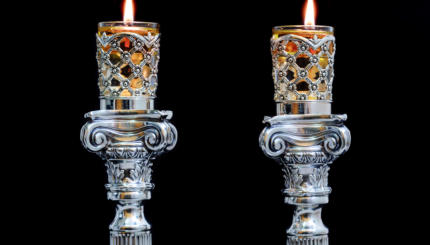In the kabbalistic seder text, Peri Eitz Hadar, Tu Bishvat is associated with God’s potency. Since human behavior can influence the cosmic balance, Tu Bishvat was viewed by mystics as a time for atoning for male sexual improprieties. In this manner the holiday–and the mystics who take part in the seder- play a crucial role in maintaining both earthly and cosmic bounty. This article, the last of three, is excerpted from a longer, footnoted work. (Read Part 1 or Part 2). It is reprinted with permission of the author from Trees, Earth,and Torah: A Tu B’Shvat Anthology, edited by Ari Elon, Naomi Mara Hyman and Arthur Waskow (Jewish Publication Society).
Because of the kabbalistic [mystical] perspective, Tu Bishvat takes on a significance that goes beyond a simple celebration of an important stage in the cycle of nature. For one thing, the symbol of the cosmic tree is so central to kabbalistic thinking that any dramatic change affecting trees in the material world must be seen as a reflection of a cosmic event of the greatest importance. Thus Tu Bishvat represents not only the New Year’s Day for trees in this world, but even more importantly, for the kabbalist, the time when the cosmic tree becomes fecund.
Since nature and all of creation is directly dependent on the spiritual bounty that is received from the cosmic tree, the kabbalistic perspective of the Peri Eitz Hadar [the book containing the kabbalistic seder] considerably magnifies the importance of Tu Bishvat. Indeed, one may say that the day becomes associated with a cosmic myth of divine potency and fertility. Thus the introduction to the Peri Eitz Hadar indicates that the central focus of the tikkun [ceremony]is the ninth sefirah [emanation]–Yesod [foundation]–which represents the divine phallus, or male generative principle within God. An emphasis is placed on contemplating the relationship between Yesod and Malkhut [kingdom], the female principle, which "bears fruit" as a result of being impregnated by Yesod.
Tu Bishvat and Divine Potency
The mythological perspective is complemented by a theurgic practice. As is often the case, kabbalistic practice involves numerical correspondences between words, or gematria. In this case, the letters of the Hebrew word for tree, ilan, have the same value as the sum of the letters that spell two divine Names, YHVH and ADoNaY. This indicates that the New Year’s Day for the ilan involves the union of the two Names. Moreover, in kabbalistic tradition, these two Names represent the male and female divine principles. When the letters of these two Names are combined to form YARDVNHY; they become an object on which a kabbalist can meditate in order to bring about the actual union of the corresponding sefirot. This meditation is appropriate for Tu Bishvat.
As a result of the association of the tikkunof Tu Bishvat with divine potency, an additional motive is discussed in the introduction to the Peri Eitz Hadar. It is assumed that the harmony of the relationship between Yesod and Malkhutis adversely affected by human sexual improprieties. Thus Tu Bishvat, with its emphasis on rectifying the sefirahYesod, becomes an occasion for correcting, or atoning for, the damage that was done to Yesodby impropersexual behavior. This introduces another mythic and magical element, the tendency to view nature’s bounty as related to, and even dependent upon, human sexuality. However, this motive is addressed through the theurgic, contemplative focus on Yesod and devotionally, through adopting an attitude of atonement.
The pietistic element, which seems to conflict to a certain extent with the otherwise celebratory character of the seder, may be a compensation for the fact that Tu Bishvat occurs during a penitential period. This period, called Shovavim, is otherwise characterized by fasting and penitential acts. The weeks of Shovavimare explicitly connected in Hemdat Yamim with correction of "damage to the [sign of the] covenant," i.e., male ejaculation in halakhically [according to Jewish law] unacceptable circumstances (shikhvat zera le-batalah).
Atoning for Sexual Misdeeds on Tu Bishvat
It is important to note the chain of associated symbols here that must be connected. Tu Bishvat is associated with trees. The cosmic tree is nourished by the sefirah Yesod. Yesod is identified with the divine phallus. The functioning of the divine phallus which impregnates Malkhut(the Tree of the Knowledge of Good and Evil) is affected by male sexuality. The time of year during which Tu Bishvat occurs is appropriate for atoning for male sexual misdeeds.
To sum up, the Tu Bishvat seder, which is presented in Peri Eitz Hadar, essentially views Tu Bishvat as part of a penitential season when atonement can be made for male sexual impropriety. As such the seder is a kabbalistic tikkun for the sefirah Yesod. As a result of this tikkun, the fertility of the cosmic tree is enhanced. This ultimately results in nature’s receiving the vitality required in order to bring forth its bounty. The tikkuninvolves three types of activity: blessing fruit, eating fruit, and meditating on the kabbalistic symbolism of the fruit. This latter activity primarily involves the contemplative study of selections from the Zoharic literature
seder
Pronounced: SAY-der, Origin: Hebrew, literally “order”; usually used to describe the ceremonial meal and telling of the Passover story on the first two nights of Passover. (In Israel, Jews have a seder only on the first night of Passover.)
Tu Bishvat
Pronounced: too bish-VAHT (oo as in boot), Origin: Hebrew, literally “the 15th of Shevat,” the Jewish month that usually falls in January or February, this is a holiday celebrating the “new year of the trees.”


